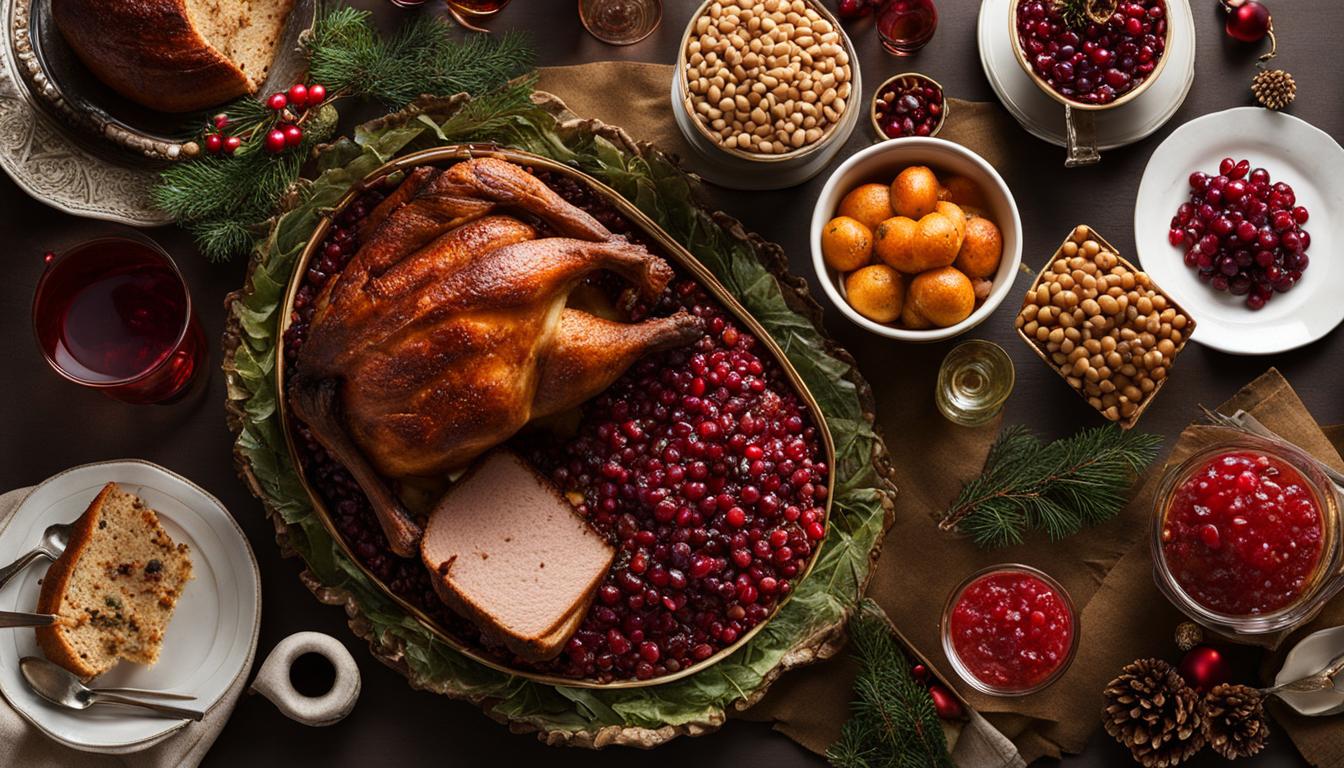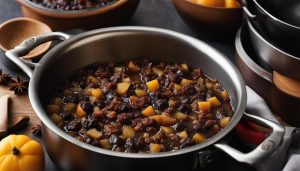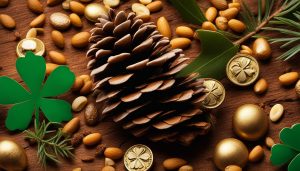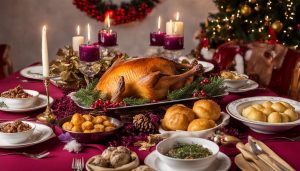Are you curious about the food that brings good luck on Christmas? Wondering what lucky foods you should eat to ensure a prosperous holiday season? Look no further! In this article, we will explore the traditional Christmas foods that are believed to bring good luck to those who partake in them.
One such food is the humble mince pie. These small pies, filled with a delightful mixture of dried fruits, nuts, and spices, have long been associated with good luck during the holidays. In fact, it is believed that eating one mince pie on each of the twelve days of Christmas will bring you good fortune. However, be warned, refusing a mince pie may lead to bad luck.
Another interesting tradition surrounding mince pies is the act of stirring the mincemeat mixture in a clockwise direction. It is believed that this ritual brings even more luck, along with making a wish while enjoying the first mince pie of the festive season.
But mince pies aren’t the only lucky foods to eat on Christmas. Keep reading to discover more about the history, symbolism, and diverse culinary traditions associated with Christmas Eve feasts.
Contents
- 1 The History and Symbolism of Mince Pies
- 2 The Tradition of Eating Fish on Christmas Eve
- 3 Other Christmas Eve Food Traditions
- 4 Creating Your Own Christmas Eve Food Rituals
- 5 Embracing the Diversity of Christmas Eve Food Traditions
- 6 Conclusion
- 7 FAQ
- 7.1 What is the significance of eating mince pies on Christmas?
- 7.2 What are mince pies made of?
- 7.3 What is the history behind mince pies?
- 7.4 Why is eating fish popular on Christmas Eve?
- 7.5 What other food traditions are associated with Christmas Eve?
- 7.6 Can I create my own Christmas Eve food traditions?
- 7.7 How can I incorporate good luck foods into my Christmas Eve feast?
- 7.8 How can I embrace the diversity of Christmas Eve food traditions?
- 8 Source Links
Key Takeaways:
- Mince pies are considered lucky Christmas food, and eating one on each of the twelve days of Christmas is believed to bring good luck.
- Stirring the mincemeat mixture in a clockwise direction and making a wish while eating the first mince pie of the festive season is considered a lucky ritual.
- Christmas Eve is celebrated with various food traditions, including the Feast of the Seven Fishes and dishes that reflect cultural heritage.
- Fish, ham, and other symbolic foods are believed to bring good luck when incorporated into the Christmas Eve feast.
- Embracing the diversity of Christmas Eve food traditions allows for the creation of personalized rituals and the celebration of different cultural backgrounds.
The History and Symbolism of Mince Pies
Mince pies have a rich history that dates back to the 16th century. Originally shaped like coffins or cradles, these pies were filled with a mixture of shredded meat and dried fruits. Over time, as spices from the Holy Land became more accessible in Europe, the recipe evolved to include a combination of dried fruits, spices, and suet. The addition of three specific spices – cinnamon, cloves, and nutmeg – was symbolic of the three gifts brought to the baby Jesus by the Magi.
The shape of mince pies also carries symbolism. The star on top of these pies represents the Christmas Star, which guided the shepherds and Magi to Bethlehem. This star serves as a reminder of the miraculous event that took place on the first Christmas. As mince pies became a staple of Christmas celebrations, their symbolism and historical significance contributed to their reputation as a traditional Christmas food.
The Tradition of Eating Fish on Christmas Eve
Eating fish on Christmas Eve is a longstanding tradition in many cultures, including Catholic and Scandinavian traditions. Fish, particularly fish pie, is the main feature of the Feast of the Seven Fishes, a Catholic tradition where a meal consisting of seven different types of fish is served. This tradition dates back to the advent fast period when fish was widely consumed as a substitute for meat. Fish pie became popular as a way to incorporate multiple types of fish into a single dish, symbolizing abundance and prosperity for the coming year.
In addition to its religious significance, eating fish on Christmas Eve has become a way to celebrate the bounty of the sea and honor the tradition of fasting during advent. It is believed that fish, being associated with water, brings good luck and blessings for the year ahead. The ritual of enjoying fish, whether it’s fish pie or other seafood dishes, has become a cherished part of many families’ Christmas Eve celebrations.
To further explore the tradition of fish on Christmas Eve, let’s take a look at a table showcasing the different types of fish commonly enjoyed during this festive occasion:
| Fish | Country/Culture | Preparation |
|---|---|---|
| Cod | Scandinavian | Salted or dried, baked or fried |
| Sole | Italian | Stuffed and baked |
| Salmon | Irish | Grilled or smoked |
| Sardines | Portuguese | Grilled or canned |
As you can see, the types of fish and their preparations vary depending on the cultural traditions. Whether you choose to follow a specific tradition or create your own, incorporating fish into your Christmas Eve feast is a meaningful way to honor the customs and bring good luck for the holiday season.
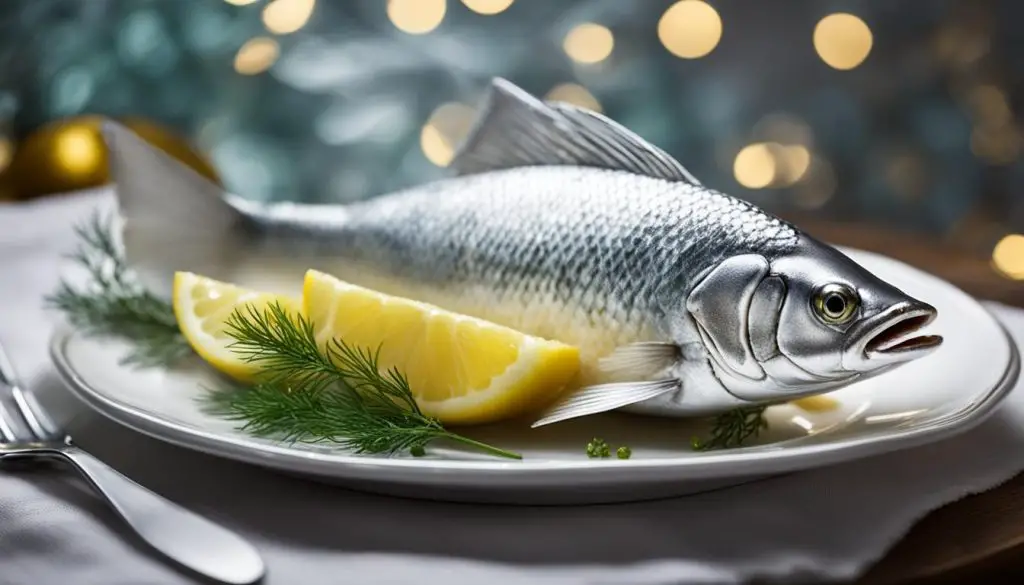
Other Christmas Eve Food Traditions
Alongside the tradition of eating fish on Christmas Eve, there are other food traditions that are celebrated by people from diverse backgrounds. One popular choice is ham, which has its origins dating back to the Martinmas slaughter in the winter. The sweet and savory flavors of ham make it a delicious centerpiece for any Christmas Eve feast.
In addition to ham, different cultures have their own unique traditional holiday dishes. For example, Italians have a multi-course fish-based dinner called the Feast of the Seven Fishes. This meal consists of seven different seafood dishes, symbolizing the seven sacraments of the Catholic Church. Irish tradition, on the other hand, includes spiced beef as a staple Christmas Eve dish.
Scandinavian countries, such as Sweden and Denmark, also have their main feast on Christmas Eve. They celebrate with dishes like pickled herring, which is traditionally served with potatoes and sour cream, as well as roast pork. These dishes reflect the rich culinary heritage of each culture and add a special touch to Christmas Eve celebrations.
Table: Traditional Christmas Eve Dishes from Around the World
| Country | Traditional Dish |
|---|---|
| Italy | Feast of the Seven Fishes |
| Ireland | Spiced Beef |
| Sweden | Pickled Herring |
| Denmark | Roast Pork |
These diverse food traditions offer an opportunity to honor cultural heritage and experience the flavors of different cuisines. Whether you choose to incorporate ham, fish, or other traditional holiday dishes into your Christmas Eve feast, you can create a memorable meal that reflects the richness and diversity of global culinary traditions.
Creating Your Own Christmas Eve Food Rituals
Christmas Eve in the UK is a blank canvas, waiting for you to create your own culinary traditions and personalized rituals. With no national dish to dictate your menu, you have the freedom to explore diverse culinary choices and make them your own. This is the perfect opportunity to cherry-pick the best traditions from around the world and incorporate them into your festive feast.
Whether you want to embrace the tradition of fish pie on Christmas Eve, or add a global touch by including dishes from Italian, Irish, or Scandinavian cuisines, the choice is yours. You can create a multi-course feast that reflects your own cultural heritage or mix and match dishes that simply excite your taste buds. The key is to create a meaningful tradition that adds joy and significance to your holiday celebrations.
By incorporating different foods and culinary rituals into your Christmas Eve traditions, you can create a truly unique and memorable experience for yourself and your loved ones. Whether it’s enjoying a traditional ham alongside a plate of pickled herring, or savoring the rich flavors of spiced beef alongside mince pies, the blending of different culinary traditions can offer a delightful fusion of tastes and a celebration of diverse cultural heritage. Your Christmas Eve feast can become a reflection of your own personal journey, with every dish telling a story and adding its own special touch to the festivities.
So, this Christmas Eve, embrace the spirit of exploration and make your own traditions. Let your taste buds guide you on a culinary adventure that celebrates diversity and creates memories to last a lifetime. Whether you choose to follow age-old customs or create entirely new ones, the magic of Christmas lies in the joy of coming together and sharing a meal that is uniquely yours.
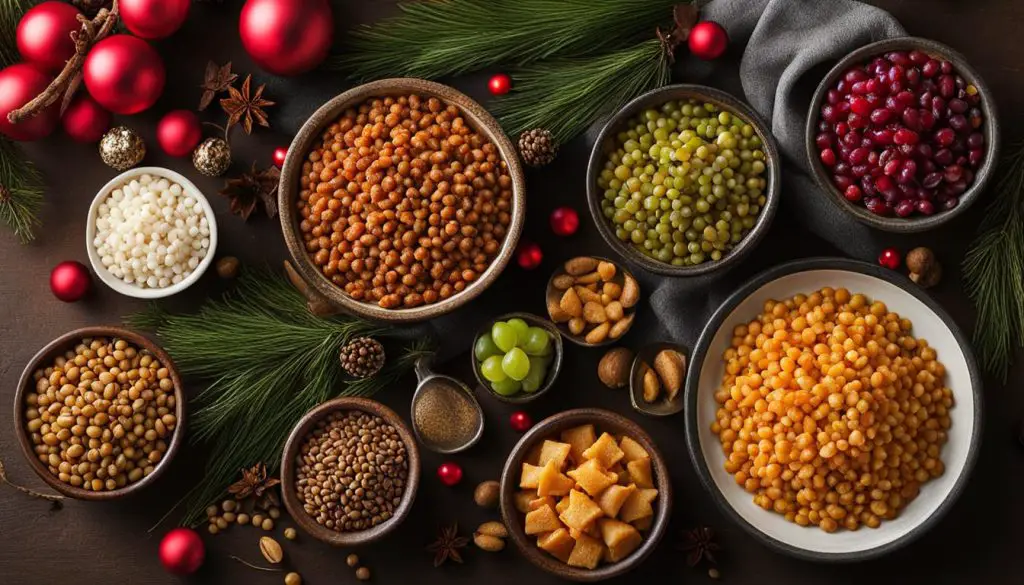
Embracing the Diversity of Christmas Eve Food Traditions
Christmas Eve is a time to celebrate the diversity of culinary traditions from around the world. It’s an opportunity to explore the flavors and customs of different cuisines, while also honoring your own cultural heritage. By incorporating diverse culinary traditions into your Christmas Eve feast, you can create a truly global celebration that reflects the richness of our multicultural society.
Whether you choose to include Italian, Irish, Scandinavian, or other cultural dishes, the key is to embrace the uniqueness of each tradition. For example, you could prepare a traditional Italian Feast of the Seven Fishes, featuring dishes like baccalà (salted cod) and calamari. Or you could incorporate Irish spiced beef, a dish that has been a part of Irish Christmas Eve celebrations for generations.
When planning your Christmas Eve menu, consider the symbolism behind the different foods. Each dish may have its own significance and meaning in its respective culture. By understanding and appreciating these traditions, you can create a deeper connection to the food you prepare and serve.
So, this Christmas Eve, take the opportunity to step outside your culinary comfort zone and embrace the diversity of food traditions. Whether you’re celebrating your own cultural heritage or simply exploring new flavors, let the global celebrations inspire your feast and create a memorable experience for you and your loved ones.
Table: Christmas Eve Food Traditions from Around the World
| Culture | Traditional Dish |
|---|---|
| Italy | Feast of the Seven Fishes |
| Ireland | Spiced Beef |
| Scandinavia | Pickled Herring |
| Mexico | Tamales |
| Poland | Cabbage Rolls |
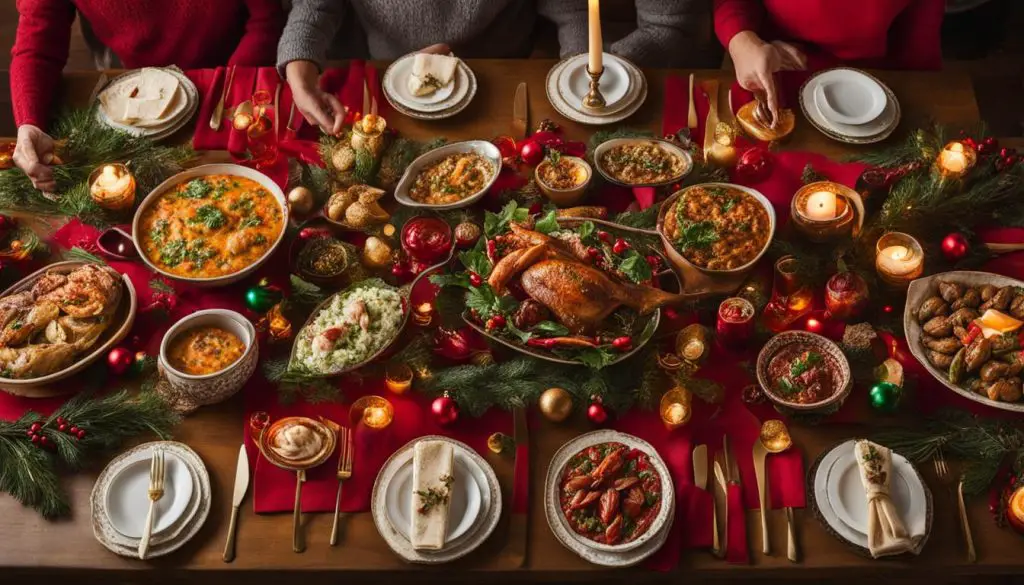
Conclusion
As Christmas Eve approaches, it’s time to create your own unique traditions and rituals around food. While there may not be a specific national dish for this day in the UK, the possibilities are endless, allowing you to explore the rich tapestry of traditional holiday foods. Embrace the cultural significance of food and use it as a way to connect with your heritage or simply to enjoy the flavors of different cuisines.
By incorporating foods believed to bring good luck, such as mince pies or fish, you can add an extra layer of symbolism to your Christmas Eve feast. And don’t be afraid to mix it up and create new traditions that reflect your own family’s tastes and preferences. The beauty of Christmas Eve is that it’s a culinary free-for-all, giving you the freedom to make it your own.
Remember, Christmas is a time to come together and celebrate the traditions that make this holiday special. Whether you’re honoring your cultural heritage or creating new traditions, the joy of sharing a meal with loved ones remains at the heart of it all. So, as you gather around the table on Christmas Eve, savor the traditional holiday foods, embrace the cultural significance of food, and create memories that will last a lifetime.
FAQ
What is the significance of eating mince pies on Christmas?
Mince pies are considered good luck to eat on Christmas. It is believed that eating one mince pie on each of the twelve days of Christmas brings good luck, while refusing one may lead to bad luck.
What are mince pies made of?
Mince pies are small pies filled with a mixture of dried fruits, nuts, and spices. The filling, called mincemeat, traditionally includes ingredients like raisins, currants, candied peel, spices (such as cinnamon, cloves, and nutmeg), suet, and sometimes brandy or other spirits.
What is the history behind mince pies?
Mince pies have been a part of Christmas celebrations since the 16th century. They were originally shaped like coffins or cradles and contained shredded meat along with dried fruits. Over time, the recipe evolved to include a mixture of dried fruits, spices, and suet. The spices are symbolic of the three gifts brought to the baby Jesus by the Magi, and the star on top of mince pies represents the Christmas Star that guided the shepherds and Magi to Bethlehem.
Why is eating fish popular on Christmas Eve?
Eating fish, particularly fish pie, on Christmas Eve is a tradition in many cultures. It is believed to bring good luck for the coming year. The Feast of the Seven Fishes is a Catholic tradition where a meal consisting of seven different fishes is served. Fish was widely consumed during the advent fast period, which included Christmas Eve.
What other food traditions are associated with Christmas Eve?
In addition to fish, other food traditions on Christmas Eve include ham, spiced beef, and various cultural dishes. Italians have a multi-course fish-based dinner, while Irish tradition includes spiced beef. Scandinavian countries, such as Sweden and Denmark, have their main feast on Christmas Eve, with dishes like pickled herring and roast pork.
Can I create my own Christmas Eve food traditions?
Absolutely! In the UK, Christmas Eve lacks a universal food tradition, allowing individuals and families to create their own rituals. You can incorporate dishes from different cultures and traditions into your Christmas Eve feast and make it personalized and meaningful.
How can I incorporate good luck foods into my Christmas Eve feast?
By including foods like mince pies, fish, and dishes that reflect your cultural heritage, you can add an extra layer of meaning and symbolism to your Christmas Eve celebrations. These foods are believed to bring good luck and can enhance the festive atmosphere.
How can I embrace the diversity of Christmas Eve food traditions?
Embracing the diversity of culinary traditions around the world allows you to celebrate and honor the richness of these traditions. Whether you choose to incorporate dishes from different cultures or simply enjoy the flavors and customs of various cuisines, it’s a way to appreciate the global celebrations that Christmas brings.

